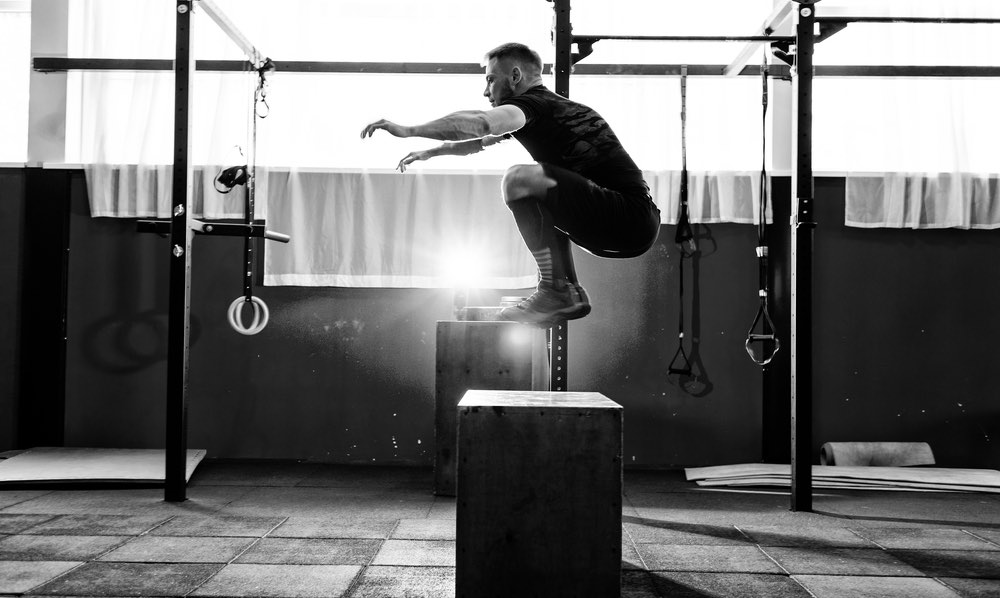Build explosive speed and power with box jumps
Box jumps are a rarity on the gym floor for having two huge and complementary benefits: they help craft a lean and defined physique while also dramatically improving your athletic prowess. Here’s how you use box jumps the smart way to burn fat as well as build explosive muscular speed, strength, size and power, says New Body Plan’s Joe Warner
Box jumps are an exercise often relegated to the domain of hardcore athletes, CrossFitters and boot-camp enthusiasts. But this power-promoting plyometric move should have more universal appeal, especially among men wanting to improve their physique and enhance their athletic prowess. That’s because box jumps tick many big boxes of training: they burn fat; they build bigger and stronger muscles; and they improve speed, power, co-ordination, and cardiovascular fitness. This makes them an essential component of any serious training regime. Here’s how you can incorporate box jumps into your plan to reap the rewards you want!
TL;DR Box jumps are your golden ticket to a strong, lean and defined physique, improved athletic power, speed and endurance, and can be used at the start of a session as part of a big-lift activation warm-up, or at the end of the session as a heart-pumping finisher. Put them wherever you need them in your workout; just don’t leave them in your locker.
Find your perfect fat-loss plan!
Take the New Body quiz!
What is a box jump?
Box jumps are a plyometric exercise, a distinct category of workouts aimed at producing maximum force in brief time intervals. The exercise necessitates an individual to leap onto and descend from a sturdy platform. This movement not only presents a challenging test to your strength but also pushes your coordination and balance capabilities.
Given its dynamic nature, the box jump provides a welcome change from monotonous exercise routines, keeping you mentally engaged. Moreover, its kinetic architecture targets your body’s power output, making it a potent tool for any athlete or individual keen on enhancing their physical performance.
What muscles do box jumps work?
The box jump is a full-body exercise that primarily targets your lower body muscles. These include the quadriceps, hamstrings, glutes, and calves – the powerhouses of your body. Additionally, it engages your core muscles which act as stabilisers during the exercise. This wide-spectrum muscular engagement is one of the reasons why box jumps are so effective in developing a well-rounded physique.
Plyometric exercises like box jumps have a “significant effect on the muscle-tendon system, stimulating strengthening adaptations”, says one study published by the Journal of Strength and Conditioning Research. This effect not only promotes muscle growth but also enhances the functionality of your muscles, improving overall fitness and performance.
Why are box jumps so good?
Beyond shaping your lower body and core, they are a sterling way to enhance your explosive power and speed, which are critical for athletic performance. They act on your muscles in a way that traditional weight lifting exercises do not, triggering the fast-twitch fibres responsible for generating power.
Additionally, box jumps contribute to cardiovascular health, providing an aerobic workout that increases heart rate and improves lung capacity. This makes them an effective tool for enhancing endurance and overall cardiovascular fitness. And due to their high-intensity nature, they make for an excellent calorie burner both during and after doing them, adding another dimension to their efficacy in supporting a lean physique.
How do I perform a box jump?
Executing a box jump perfectly requires an emphasis on form and control. Stand in front of a sturdy, non-slip box or platform. Lower yourself into a half squat position, engaging your core and keeping your back straight. Propel yourself upwards using your lower body muscles, simultaneously swinging your arms for momentum. It’s essential to land on the box softly, bending your knees to absorb the impact. Achieve a full standing position, then step or jump back down. Remember to maintain control throughout, especially when landing, to avoid injuries. See below for more on how to do the move as well as sets and reps info.
Should I do box jumps at the beginning, middle or end of my session?
Considering their high-intensity nature it is generally recommended to perform them at the start of your workout session when you’re fresh and less likely to make fatigue-induced mistakes. This is crucial as box jumps demand both physical strength and mental alertness for maintaining proper form.
The American Council on Exercise explicitly emphasises the importance of correct form in plyometric training to avoid injuries. Incorporating them early in your routine allows you to perform the exercise at your peak energy level, thus maximising the benefits and minimising the risk of injury.
What equipment do I need to do box jumps?
The primary piece of equipment needed is a sturdy, non-slip box or platform of appropriate height. The height of the box is determined by your current fitness level and can be adjusted as your strength and confidence increase. The box should provide a firm, stable landing surface.
For safety reasons, avoid any box or platform that is unsteady or has a slippery surface. While box jumps can be performed with additional equipment such as weighted vests, the focus should always be on maintaining proper form and control.
What other moves are similar to box jumps?
Box jumps belong to the broader category of plyometric exercises, which involve exerting maximum force in short bursts to increase power. Other plyometric exercises that offer similar benefits include burpees, jump squats, and jump lunges.
These exercises promote muscular strength and endurance, cardiovascular fitness, and explosive power. They can be seamlessly incorporated into your workout routine to provide a diverse and well-rounded training programme.
Is the box jump suitable for beginners?
They can be suitable for beginners when performed correctly and with appropriate modifications. Novices should start with a lower box to master the form and minimise the risk of injury. As strength, confidence, and technique improve, the box height can be gradually increased. Beginners should also ensure to start with fewer repetitions and gradually increase as their fitness levels improve. It’s essential to listen to your body and progress at your own pace.
What else do I need to know?
Box jumps, like any exercise, require a proper understanding and respect for your body’s capabilities and limitations. It’s crucial to focus on quality over quantity, ensuring each jump is performed with correct form and control. This not only maximises the benefits but also prevents potential injuries. Remember to land softly to protect your joints and maintain balance. Furthermore, warm up adequately before starting your session to prepare your body for the high-intensity workout and cool down afterward to help your body recover.
How to do box jumps
- Ensure a comprehensive warm-up
- Select a sturdy, non-slip box of appropriate height
- Prioritise form and control over speed and repetitions
- Land softly to minimise the impact
- Cool down and stretch post-workout to aid recovery
How many box jump reps should I do?
The number of reps for box jumps can vary based on your current fitness level and goals. A general guideline is to aim for 10-20 reps per set. It’s essential to prioritise form and control over the number of reps. As your strength and technique improve, you can gradually increase the number of reps.
How many sets should I do?
As with reps, the number of sets can be adjusted based on your individual needs and goals. Aiming for 3-5 sets of box jumps can provide a solid workout while allowing time for adequate rest between sets.
How much weight should I lift?
Box jumps are predominantly bodyweight exercises and do not typically involve lifting weights. However, for those looking to increase the challenge, weighted vests can add a degree of resistance to the workout. It’s important to only add weight once you’ve mastered the technique and can perform the exercise with good form.
Box jump progression exercise
To increase the intensity of your box jumps, consider adding a burpee before each jump. This will further engage your muscles and boost your cardiovascular workout.
Box jump regression exercise
For beginners or those looking for a less intense variation, step-ups on the box can serve as an excellent starting point. This allows for the engagement of similar muscle groups without the high impact of the jump.
Find your perfect fat-loss plan!
Take the New Body quiz!

